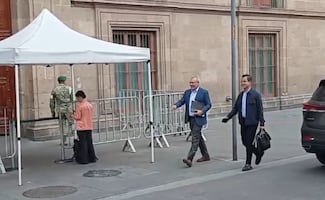Más Información

Senador del PT propone crear televisión, radio y periódico de la 4T; debemos hacer frente a medios de derecha, dice

César Duarte comparece ante jueza en penal del Altiplano; buscan vincularlo por presunto lavado de dinero

¿Qué es el Tratado de Aguas de 1944 entre México y EU por el que Trump amaga con imponer aranceles?; te explicamos

Gobernador de Michoacán se reúne con Sheinbaum en Palacio Nacional; acude también gabinete de Seguridad

Posponen en el Senado discusión y votación de reforma para crear la figura de “jueces sin rostro”; se discutirá en febrero

VIDEO Hallan a pareja sin vida en colonia Lindavista; una de las víctimas era abogado que litigó temas de despojos en Ecatepec
The National Autonomous University of Mexico (UNAM) will present a photography exhibition on Mesoamerican art in Canada from November 30 to February 8, 2019 .
The exhibition "Mesoamerican Legacy, Canadian Treasure, World Heritage" features 13 professional photographs of artifacts taken from the collection of the Canadian Museum of History , including: Vessels, pectorals, an anthropomorphic whistle, and representations of members of society .
The exhibition was staged in collaboration with the Canadian Museum of History and the Autonomous University of Mexico City (UACM) .
There are photographs of pieces that have never been shown to the public and that come from Mesoamerican territories: Mayan, Teotihuacan, and mainly from western Mexico , representing the three periods of study: Pre-Classic, Classic and Post-Classic.
As part of the activities related to the exhibition, conferences will be held in Spanish, French, and English , as well as a workshop on the process of authentication of the pieces and the screening of the documentary "El Penacho de Moctezuma: Plumaria del México Antiguo" (Moctezuma’s Headdress: Featherwork of Ancient Mexico) .
The video, co-produced by the Public Broadcasting System of the Mexican State (SPR) of the Ministry of the Interior, and TV UNAM , tells the story of the Moctezuma's Headdress, considered one of the most emblematic pieces of prehispanic clothing.
The exhibition will be moved to Mexico later and presented at the Cuautepec campus of the Autonomous University of Mexico City (UACM) from February 27 to March 29, 2019 .
"The Canadian Museum of History has an important collection of different artifacts from the original peoples of Mexico and many of them will be shown to the public for the first time," Alicia Mayer, director of UNAM Canada, told Notimex .
Master Gerardo Familiar Ferrer
served as curator for the exhibition. He is a historian who specializes in Mesoamerican culture, a museologist, and technical secretary of this representation in Gatineau, Québec .
He pointed out that the exhibition was the result of more than three years of work and a careful selection of Mesoamerican objects from the Canadian Museum of History "to attract the interest of both researchers and students."
dm
Noticias según tus intereses
[Publicidad]
[Publicidad]









